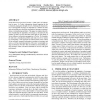146 search results - page 4 / 30 » Spectrum based fraud detection in social networks |
KDD
2006
ACM
14 years 8 months ago
2006
ACM
Statistics on networks have become vital to the study of relational data drawn from areas such as bibliometrics, fraud detection, bioinformatics, and the Internet. Calculating man...
WCNC
2010
IEEE
13 years 11 months ago
2010
IEEE
Abstract—In this paper two different cognitive radio architectures, i.e. stand-alone and distributed, are proposed for spectrum sensing purposes. In particular, both architecture...
WWW
2011
ACM
13 years 2 months ago
2011
ACM
Social network services have become a viable source of information for users. In Twitter, information deemed important by the community propagates through retweets. Studying the c...
ASUNAM
2010
IEEE
13 years 9 months ago
2010
IEEE
Abstract--As research into community finding in social networks progresses, there is a need for algorithms capable of detecting overlapping community structure. Many algorithms hav...
MOBIHOC
2009
ACM
14 years 8 months ago
2009
ACM
Cognitive radio networks are emerging as a promising technology for the efficient use of radio spectrum. In these networks, there are two categories of networks on different chann...

